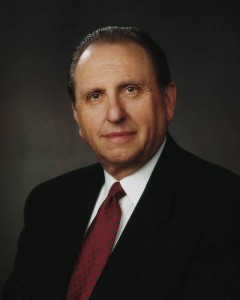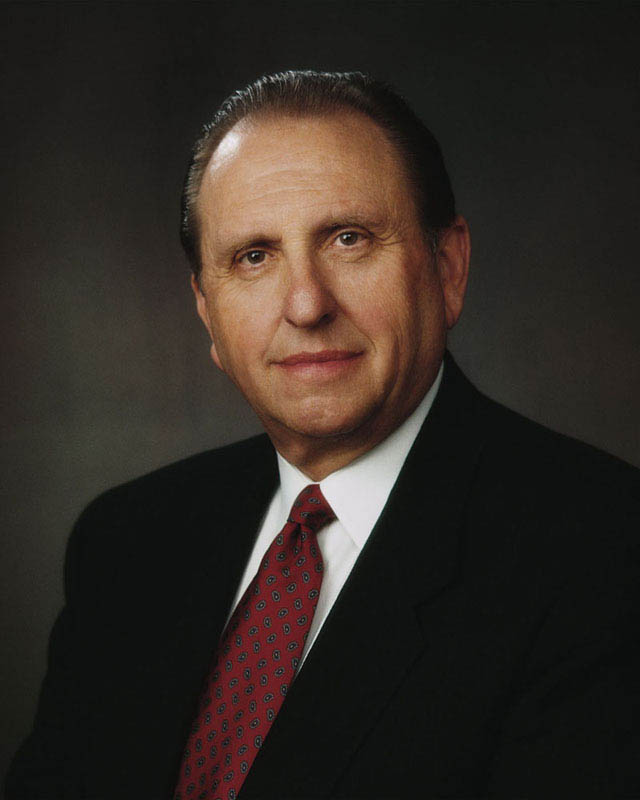At the death of Gordon B. Hinckley, the world leader of the Mormon Church, many people wondered two things. The first was a “who” question: who would be the next leader?
That was settled Monday, February 4th when the Church announced that Thomas S. Monson would be the next world leader.
 However, there is another question. It is the omnipresent “how” question: How does one man run a church with thirteen million members?
However, there is another question. It is the omnipresent “how” question: How does one man run a church with thirteen million members?
This question was also answered at this same press conference. President Thomas S. Monson called Presidents Henry B. Eyring and Dieter F. Uchtdorf as counselors. He also called Boyd K. Packer to be the president of the Council of Twelve Apostles.
Notice what the top organization of the Mormon Church is: it is not one man—or even one superman—but a body of men who serve in councils. This system of small bodies of men, rather than one glowing superstar, has so many advantages over other systems.
For example, and by contrast, the Pope has a College of Cardinals with 199 members. This is a rather bulky and unwieldy body, which is why the college has its own subdivisions—cardinal dean, cardinal vice dean, the order of priests and the order of deacons. But you see the problem when you have a “board of directors” with a 1:199 ratio to the “president.”
Or take the cabinet of the United States president. There are fifteen secretaries. Additionally there are other bodies called “cabinet level positions,” which include the vice president, the chief of staff, the OBM, the EPA, the National Drug Control Policy, and the US Trade Representative. The total is 21, which is a better ratio (1:21 as opposed to 1:199), but it too can be cumbersome.
Right from the beginning Joseph Smith proposed a different system. When he organized the Mormon Church, he was set apart as the First Elder. But he also called Oliver Cowdery to be the Second Elder. Mormons believe that God guided Joseph Smith to do this because it would be impossible for one man to run the church as a solo act.
Any man, no matter how talented and gifted—or even a man called of God for that matter—needs help and support. When Moses took the children of Israel into the wilderness, he did the “one man show” approach to managing problems. His father-in-law, however, suggested another approach.
“The thing that thou doest is not good. Thou wilt surely wear away, both thou, and this people that is with thee: for this thing is too heavy for thee; thou art not able to perform it thyself alone.”
“Hearken now unto my voice, I will give thee counsel, and God shall be with thee: Be thou for the people to God-ward, that thou mayest bring the causes unto God: And thou shalt teach them ordinances and laws, and shalt shew them the way wherein they must walk, and the work that they must do.”
“Moreover thou shalt provide out of all the people able men, such as fear God, men of truth, hating covetousness; and place such over them, to be rulers of thousands, and rulers of hundreds, rulers of fifties, and rulers of tens: And let them judge the people at all seasons: and it shall be, that every great matter they shall bring unto thee, but every small matter they shall judge: so shall it be easier for thyself, and they shall bear the burden with thee.”
“If thou shalt do this thing, and God command thee so, then thou shalt be able to endure, and all this people shall also go to their place in peace.” (Exodus 18:17-23)
By spreading the workload among capable men, Moses increased his efficiency and his effectiveness as a leader. Simply put, he delegated. This is the genius of councils: the leader is empowered by empowering others. President Monson can do much more with Presidents Eyring and Uchtdorf assuming part of the workload. What they cannot do, the Twelve can.
Also, using a council system helps in case of absence or emergency. Think of what happens when a US president is incapacitated. Of course the duties devolve upon the vice president, as stated in the 25th Amendment. But in this system of councils, the first and second counselor can step in without a “constitutional crisis.” This backup system also works when the leader is on vacation, or needs to be in two places at once. A counselor has been meeting with the leader and is up to speed on decisions, programs, and polices.
So Joseph Smith began with First and Second Elders, and six members. Over time church membership grew. As the membership grew, so did the church organization. The First Presidency (the supreme governing body) consisting of three members was organized in March 1832. Then the Council of Twelve Apostles (the second highest governing body) was organized on February 14, 1835. The Quorums of the Seventy (the third highest body) were organized a few days later on February 28, 1835.
Keep in mind that Church membership in 1835 was not 13 million. Yet at that time Joseph Smith was laying the foundation for a church that would eventually grow into the millions. Even so, over time this upper organization has remained relatively intact. There have been increases in the number of the lower councils, but the two top-tier ranks have been the same.
Having been in presidencies and on similar-type councils, I am impressed how well it works on a practical level. You have people who can assume delegated roles at hand. Two people can step in for you. And you have other people you can turn to for advice. If two heads are better then one, then three heads must be even better. It works much better than running the thing as a lone wolf.
One last note. When we look at the Mormon Church, we usually focus on the 13 million members, the 125 temples, the 27,475 congregations, and so forth. But that is just one way of looking at things. President Boyd K. Packer, the president of the Council of Twelve Apostles, once noted:
“Often we are asked how the relatively few Apostles in the First Presidency and the Twelve can manage the Church, now more than 10 million strong. Actually the Church is no bigger than a ward.” (Boyd K. Packer, “The Bishop and His Counselors,” Ensign, May 1999, 57)
The focus of the church is at the local level—the wards (local congregations), the families, the people. Christ suffered for individuals, one by one. The church also has the same focus: it is not the 13 million; it is the one.
About kendalbhunter
Twitter •


